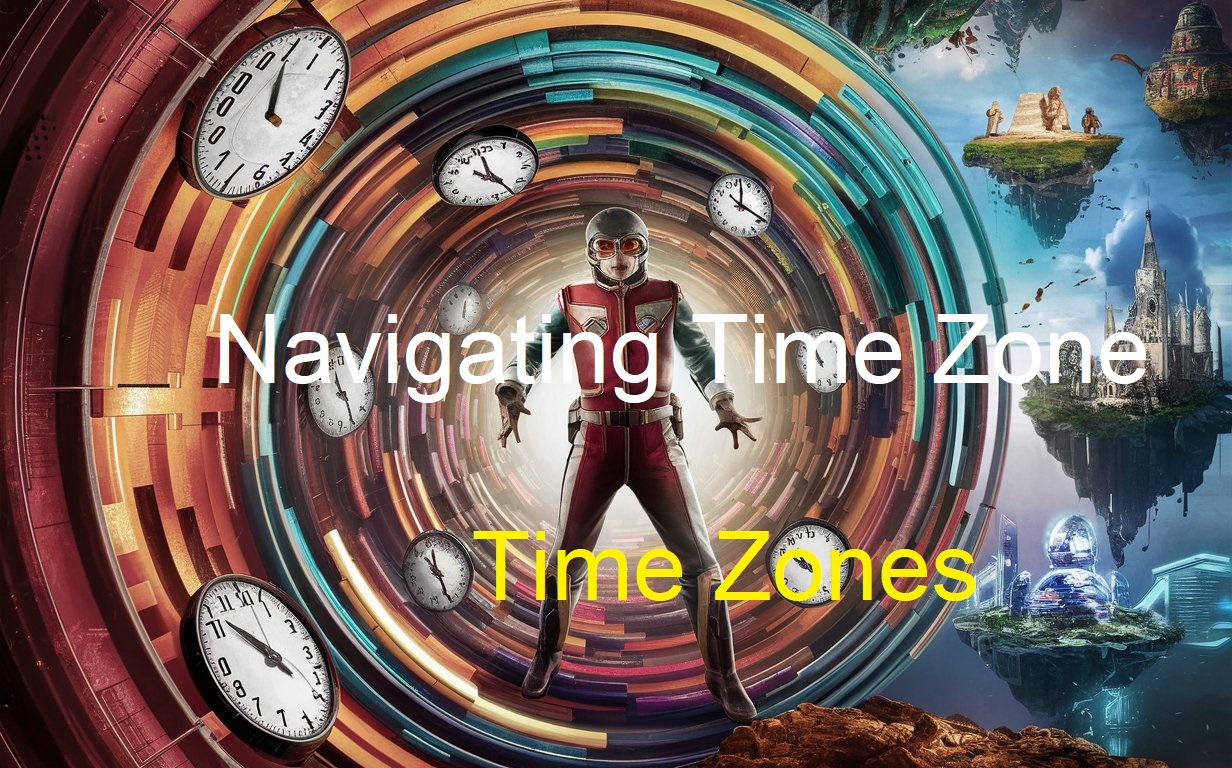Navigating Time Zone: Welcome to the ultimate guide on navigating time zones! Have you ever found yourself baffled by the concept of different time zones and how they affect our daily lives? Well, fret not, because we are here to unravel the mystery behind time zones and provide you with all the essential information you need to become a time zone pro. From understanding GMT and UTC to mastering daylight saving time adjustments, this comprehensive guide will equip you with the knowledge to seamlessly navigate through various time zones like a seasoned traveler. So sit back, relax, and let’s embark on this exciting journey through different dimensions of time!
What are Time Zones?
Time zones are geographical regions that follow a uniform standard time to regulate clocks and schedules within that area. The Earth is divided into 24 time zones, each approximately 15 degrees of longitude wide, with the Prime Meridian at Greenwich as the reference point for Coordinated Universal Time (UTC). As the Earth rotates on its axis, different parts experience daylight and darkness at varying times, leading to the need for standardized time measurements. This system allows countries around the world to coordinate activities such as travel, communication, and commerce efficiently. Understanding time zones is crucial when planning events or meetings across different regions to ensure everyone is on the same temporal page. So next time you glance at your watch or check your phone for the current time, remember that it’s all part of this fascinating global synchronization called time zones!
History of Time Zones
The history of time zones dates back to the 19th century when the need for a standardized way to track time globally became apparent. Before the establishment of time zones, each city would set its local mean time based on the position of the sun at noon.
As rail travel expanded, it became increasingly challenging to schedule trains without a uniform system of timekeeping. This led Sir Sandford Fleming to propose dividing the world into 24 time zones, each one representing an hour of difference from Greenwich Mean Time (GMT).
On November 18, 1883, this concept was implemented by major railroad companies in North America and eventually adopted worldwide at the International Meridian Conference in 1884. The Prime Meridian at Greenwich Observatory in London was chosen as the starting point for calculating standard time.
This historical development revolutionized global communication and transportation systems, making it easier for people to coordinate activities across vast distances. Today, thanks to this innovation, we can seamlessly navigate through different time zones with ease and precision.
The Purpose of Time Zones
Time zones serve a crucial purpose in keeping the world organized and synchronized. They were established to divide the Earth into segments based on longitudinal lines, each representing a different time offset from Coordinated Universal Time (UTC). The primary goal of time zones is to ensure that time is consistent within a specific region, making it easier for people to coordinate activities, schedules, and global interactions.
By having distinct time zones, individuals across the globe can accurately determine what time it is in different parts of the world without confusion or ambiguity. This system helps facilitate international communication, transportation schedules, and commerce operations by standardizing time measurements worldwide.
Moreover, time zones play a vital role in regulating daylight hours and optimizing energy consumption. By aligning sunrise and sunset times with human activity patterns through localized timing adjustments, societies can make more efficient use of natural light resources while minimizing reliance on artificial lighting sources during specific times of the day.
How Many Time Zones Are There?
Have you ever wondered how many time zones there are around the world? Well, the concept of time zones was introduced to standardize timekeeping globally. Currently, there are a total of 38 different time zones in use today. These time zones are based on longitudinal divisions and vary by one hour increments.
The Prime Meridian at Greenwich, England serves as the starting point for calculating these different time zones. As you move east or west from this point, each zone represents a shift in time by an hour. This system helps us organize our activities and schedules across regions with varying local times.
Each country may have one or more time zones depending on its geographical expanse. Some countries like Russia span multiple time zones due to their vast landmass. Understanding these differences is crucial when coordinating events or communicating with people around the globe.
Knowing how many time zones exist can help us appreciate the complexity of global synchronization and enhance our awareness of temporal differences worldwide.
Understanding GMT and UTC
Have you ever wondered about the significance of GMT and UTC in the world of time zones? GMT, or Greenwich Mean Time, is based on the location of the Royal Observatory in Greenwich, London. It serves as a reference point for timekeeping worldwide. UTC stands for Coordinated Universal Time and is more accurate than GMT due to its use of atomic clocks.
Both GMT and UTC are used as standard times from which other time zones are calculated. They help synchronize activities across different regions by providing a common reference point. This standardization aids in global communication, transportation, and commerce.
Understanding GMT and UTC can be essential when planning international meetings or travel arrangements. By knowing how these time standards work, you can avoid confusion and ensure punctuality in your engagements across various time zones.
Next time you check the clock to coordinate with someone halfway around the world, remember that it all boils down to understanding GMT and UTC!
Commonly Used Time Zone Abbreviations
Time zones can be a bit confusing, especially when you start seeing all those abbreviations like EST, PST, and GMT. But fear not! These acronyms actually make it easier to understand the different time zones around the world.
EST stands for Eastern Standard Time and is used in regions like New York or Miami. It’s 5 hours behind Greenwich Mean Time (GMT). On the other hand, PST refers to Pacific Standard Time and is observed in cities like Los Angeles or Seattle – it’s 8 hours behind GMT.
Then there’s GMT itself, which stands for Greenwich Mean Time. This is often considered the starting point for measuring time zones worldwide. UTC, or Coordinated Universal Time, is essentially equivalent to GMT but is more precise due to atomic clocks.
Other common abbreviations include CST (Central Standard Time), MST (Mountain Standard Time), and AEDT (Australian Eastern Daylight Time). Each abbreviation helps us pinpoint specific regions on the global time map effortlessly.
Dealing with Daylight Saving Time
Daylight Saving Time can be a bit of a puzzle when it comes to navigating different time zones. This practice of moving the clock forward by one hour during the warmer months and then back again in the cooler months can throw off your internal clock. Suddenly, those conference calls or virtual meetings might not align with what you’re used to.
The key is to stay aware of when countries or regions observe Daylight Saving Time as not all places around the world follow this practice. This means that scheduling appointments or planning trips may require some extra attention to detail.
When traveling across time zones, especially during the transition periods for Daylight Saving Time, double-checking meeting times and adjusting your schedule accordingly can help avoid any confusion or missed connections.
Staying informed and mindful of Daylight Saving Time changes can ensure smooth sailing through different time zones!
Tips for Navigating Different Time Zones while Traveling
Traveling across different time zones can be exciting yet challenging. To make the adjustment smoother, start by syncing your devices to the local time as soon as you arrive at your destination. This small change can help your body adapt more quickly to the new schedule.
Try to gradually adjust your sleeping and eating patterns a few days before your trip if possible. This can reduce jet lag and help you acclimate faster once you arrive in a different time zone.
Staying hydrated during your journey is crucial for combating fatigue and staying alert. Make sure to drink plenty of water before, during, and after your flight to feel refreshed upon arrival.
When planning meetings or activities in different time zones, use online tools like World Time Buddy or Google Calendar’s world clock feature to easily coordinate schedules with people across the globe.
Allow yourself some downtime upon reaching your destination to relax and recharge before diving into sightseeing or work commitments. Balancing exploration with self-care will ensure an enjoyable travel experience across various time zones.
Challenges and Benefits of Working Across Multiple Time Zones
Working across multiple time zones can present both challenges and benefits for professionals. One of the main challenges is coordinating meetings and deadlines when colleagues are scattered around the world. It requires careful planning to find a suitable time that works for everyone involved. Communication can also be tricky, as immediate responses may not always be possible due to differing work hours.
On the flip side, there are numerous benefits to working across time zones. Embracing diversity in perspectives and approaches from colleagues in different regions can lead to innovative solutions and a more well-rounded team dynamic. Additionally, having team members available during various hours of the day can increase productivity by ensuring tasks are being worked on continuously.
Navigating multiple time zones requires adaptability, effective communication strategies, and a willingness to embrace collaboration beyond traditional boundaries.
Pros & Cons
Pros of navigating different time zones include the opportunity to experience diverse cultures and environments. Traveling across time zones can broaden your perspective and create memorable experiences. It allows you to explore new cuisines, traditions, and lifestyles that vary from one region to another.
On the flip side, dealing with multiple time zones can lead to jet lag and disrupt your sleep patterns. This may affect your productivity and mood when trying to adjust to a new schedule. Additionally, coordinating meetings or communication with people in different time zones can be challenging due to conflicting working hours.
Despite these challenges, adapting to different time zones can enhance adaptability skills and improve problem-solving abilities. It teaches flexibility in managing schedules efficiently while maintaining effective communication with global counterparts.
Conclusion
As we wrap up our journey through the intricate world of time zones, it’s clear that understanding and navigating them is essential in today’s globalized society. From the establishment of time zones to dealing with daylight saving time shifts, there are various factors at play when it comes to keeping track of different times around the world.
Whether you’re a frequent traveler or working across multiple time zones, challenges and benefits come hand in hand. The ability to connect with people from all corners of the globe has never been easier, yet coordinating schedules can be a daunting task.
Despite the complexities that arise from managing diverse time zones, embracing flexibility and utilizing technology can help streamline communication and collaboration. By being mindful of time zone differences and implementing effective strategies, you can make the most out of working or interacting across borders.
Keep exploring new ways to adapt and thrive in this interconnected world where time knows no boundaries.
FAQs
Navigating time zones can be a complex but fascinating aspect of our globalized world. Understanding the history, purpose, and practical implications of time zones is essential for travelers, businesses, and anyone working across different regions.
As you embark on your journey across various time zones or collaborate with colleagues from around the world, remember to keep these tips in mind. Embrace the challenges and benefits that come with working across multiple time zone, stay organized with tools like World Clocks or Time Zone Converters, and always communicate effectively to avoid any misunderstandings.
By mastering the art of navigating different time zones efficiently, you’ll not only enhance your productivity but also foster stronger connections with people from diverse backgrounds. So next time you find yourself scheduling a meeting with someone halfway across the globe or planning an international trip, approach it with confidence knowing that you have a comprehensive understanding of how to navigate through the intricacies of time zones.
FAQs
Q: How many official time zones are there?
A: There are 24 official time zones worldwide. However, some regions observe half-hour or even quarter-hour deviations from standard full-hour offsets.
Q: What is daylight saving time?
A: Daylight saving time (DST) is the practice of setting clocks forward by one hour during warmer months to extend evening daylight. Not all countries or regions observe DST.
Q: How does GMT differ from UTC?
A: GMT (Greenwich Mean Time) was traditionally based on astronomical observations at the Royal Observatory in Greenwich while UTC (Coordinated Universal Time) is more precisely determined using atomic clocks. Despite this difference in calculation methods, both reference points generally show identical times.
Visit More: https://whattimezone.com/









Hi, this is a comment.
To get started with moderating, editing, and deleting comments, please visit the Comments screen in the dashboard.
Commenter avatars come from Gravatar.